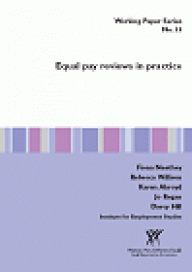Publications
 We author and publish a range of resources to keep you up to date with the latest developments in employment, labour market and human resource policy and practice.
We author and publish a range of resources to keep you up to date with the latest developments in employment, labour market and human resource policy and practice.
All our pdf publications are free to access.
-

The Contribution of Skills to Business Performance
Tamkin P | Jul 2005 | Department for Education and SkillsThis report explores the literature linking skills with business performance, and also the wider HR and High Performance literature and studies on engagement. It highlights a wide range of studies that provide evidence of benefits for individuals and organisations, from skills, training and development.
-

Equal Pay Reviews in Practice
Neathey F, Willison R, Akroyd K, Regan J, Hill D | Jun 2005 | Equal Opportunities CommissionThis report sets out the findings of a qualitative study of organisations' experiences of conducting equal pay reviews (EPRs). It is based on findings from 15 case studies which involved interviews with employer, trade union and line management representatives who had been involved in conducting an EPR.
-
📄
Business Models and Change
the Effect on Employees and their Psychological Contracts
Wolfe H | Jun 2005 | Institute for Employment StudiesThe paper asks the following questions: What is business model change, how does is occur, and how is it dealt with? How does business model change affect the employment expectations and how can these be managed? What are the psychological contract effects of business model change? How can change be effectively and appropriately designed and communicated for optimum organisational performance and employee well-being?
-

Post-16 Transitions: a Longitudinal Study of Young People with Special Educational Needs (Wave Three)
Aston J, Dewson S, Loukas G, Dyson A | Jun 2005 | Department for Education and SkillsThis was the third wave of longitudinal research with young people with special educational needs (SEN) to record and track their progress as they moved from compulsory schooling to early adulthood.
-

Understanding Workless People and Communities
A Literature Review
Ritchie H, Casebourne J, Rick J | May 2005 | Department for Work and PensionsThis literature review firstly examines how psychosocial models are used to explain the effects that mass unemployment has on individuals. It then explores the concept of worklessness and the barriers faced by key groups of workless people. The review moves on to examine, in turn, how worklessness can be understood at the individual level, the community level, and at the level of geographical concentrations of worklessness.
-

Evaluation of Care to Learn
Interim Report 2005
Dench S, Casebourne J | May 2005 | Department for Education and SkillsThis publication is no longer available. Care to Learn is a UK government initiative that provides financial support for teenage parents who want to continue in, or return to learning. It helps with the cost of their childcare and travel. This is the second in a series of reports designed to provide an evaluation of the first three years of Care to Learn. It focuses on the operation and impact of the initiative over the 2003-04 academic year.
-
📄
NHS Learning Accounts - the NHSU project
Aldridge F, Yanina Dutton, with Robinson D, Tackey N D | May 2005 | National Institute of Adult Continuing EducationThis publication is no longer available. The NHS Learning Account Scheme was introduced in April 2001 as part of a firm commitment to widen learning and development opportunities for staff without a professional qualification. NHSU set up a pilot scheme seeking practical ways of involving a wider range of staff in taking up their entitlement to an NHS Learning Account. A key aim was to open up progression routes to 'non-traditional' learners, leading to a better-trained workforce for the NHS as a whole.
-

Intermediate Impacts of Advice and Guidance
Tyers C, Sinclair A | Apr 2005 | Department for Education and SkillsThis report looks at whether the provision of Information, Advice and Guidance (IAG) makes a difference to the work and learning outcomes of individuals.
-

Training a Mixed-Age Workforce
Practical Tips and Guidance
Newton B, Hurstfield J, Miller L, Bates P | Apr 2005 | Age Partnership Group, Department of Work and PensionsThis publication is no longer available. This project explored the barriers to training experienced by workers of different ages. The wider context for this research was the age discrimination legislation due to be implemented in October 2006. A key objective of this project was to address some of the myths and stereotypes that might deter employers from training their workers.
-
📄
Action Learning
Principles and Issues in Practice
Gifford J | Apr 2005 | Institute for Employment StudiesThis paper provides an introduction to action learning and reflects on recent advances made in its application. It focuses on practical variations of action learning and discusses in what ways they adhere to or challenge the original principles and established norms of action learning.
